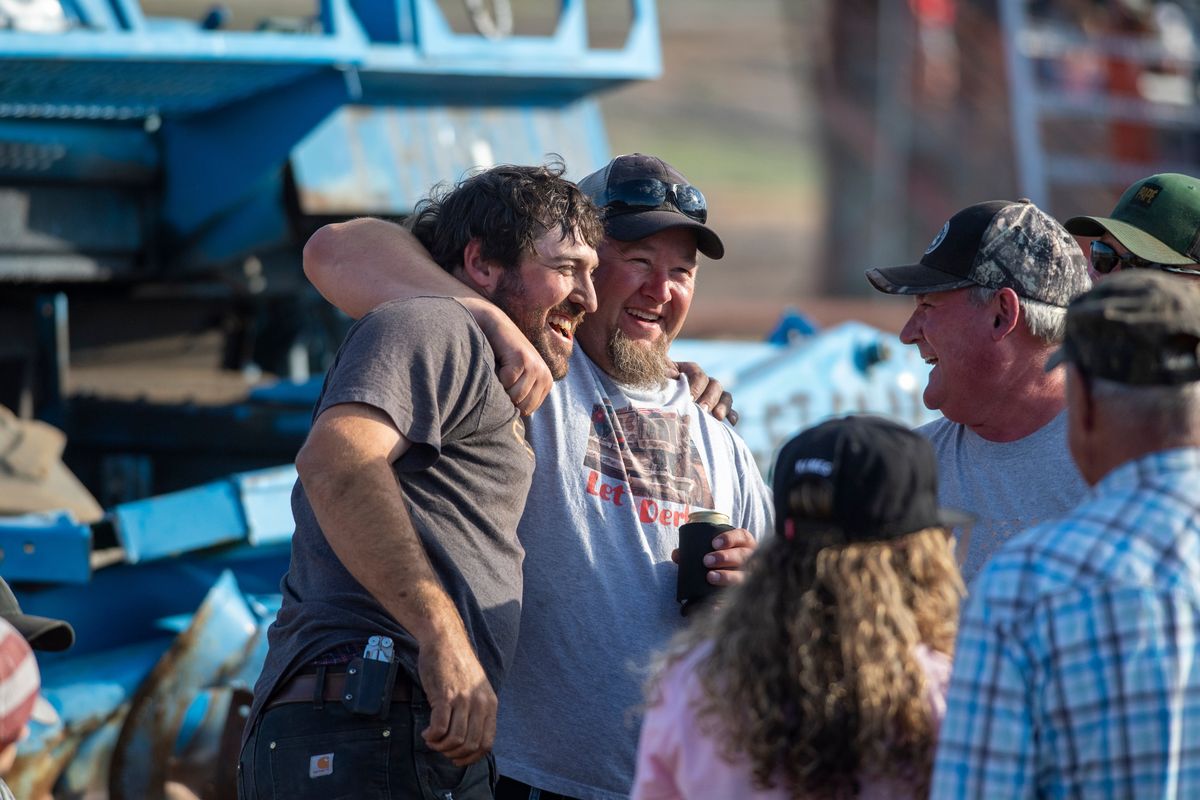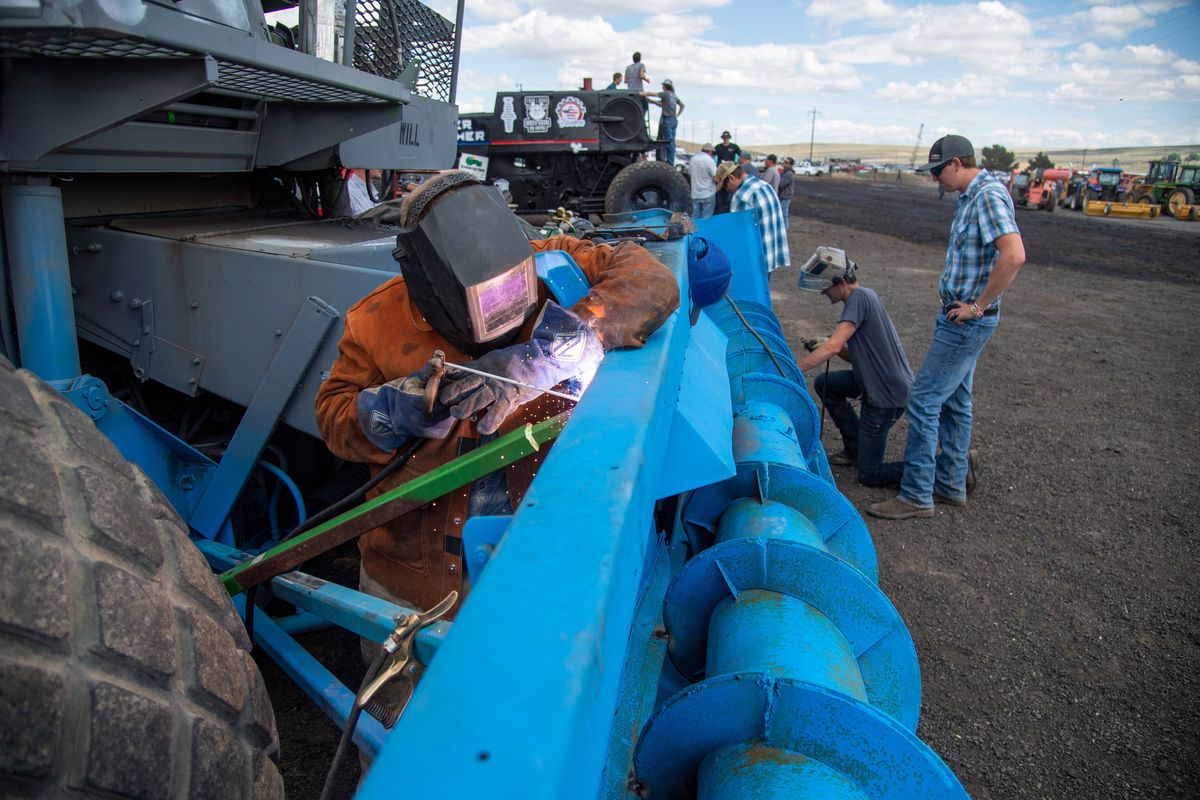‘Protect your rear end’: Combines collide in Lind with the top driver winning $1,200
Lind Combine Derby winner, Cody Bennett, left, gets a hug from his crew chief Tom Phillips at the end of main event Saturday, June 10, 2023, at the Lions Club arena in Lind, Washington. The unique event, which is a major fundraiser for the town's Lions Club and funds many local charities and causes, included three heats, a final event and several car and truck races in between. (Jesse Tinsley/The Spokesman-Review)Buy a print of this photo
LIND, Wash. – Smash! Two massive wheat harvesters rammed each other in a head-on collision, the momentum lifting their rear steer tires feet off the ground. The crowd cheered.
The drivers backed away, revved their engines, then slammed each other again, locking heads like butting rams.
The 34th Lind Combine Demolition Derby had begun.
Thousands descended upon the little town in Adams County to see the spectacle Saturday.
The friendly competition brings combine drivers from the agriculture community around the region.
“It’s a unique experience everyone should see once,” said Lane Hannas, president of the Lind Lions Club, which runs the event as a fundraiser for the community.
Fourteen combines competed in three heats.
The farm machines jousted around the arena, using their dull headers both as a weapon and as a shield to protect their side and back.
Two combines might gang up on a third, locking one in the middle. The most aggressive would reverse to the edge of the corral, then charge.
The idea is to “protect your rear end,” said Grady Gfeller, who grew up in Lind and spent the past four years preparing his John Deere 6602, painted blue and dubbed the last “Last Ditch Effort.”
Combines have large front-drive tires and small, exposed rear wheels for steering.
It didn’t take long for most combines’ rear wheels to get knocked off, causing them to drag around the back axle, losing speed and maneuverability.
All the while, black exhaust and white engine smoke billowed in what appeared to be post-apocalyptic mayhem.
When they can no longer move, the drivers tap out by waving an orange flag. They are stranded until the end of the round.
More severely damaged combines had their front wheels collapsed or tires popped.
At the end of each round, it takes a bulldozer and a telehandler forklift to tow the totaled equipment out of the arena.
Another crew rushes in to remove the leftover debris.
Between rounds, pit crews work frantically to get the combines running again for the final round.
“It’s pretty chaotic because we only have so much time,” said Chase Hubbard, a member of Gfeller’s support team. “It’s a lot of fun.”
Gfeller stalled out at the beginning of his first round after he broke his gas lever on the first hit.
“I was holding onto it, and I just broke it off,” he said.
Breaking down early in the round saved him from too much damage. He won the consolation round and advanced to the final.
Eight combines battled in the last showdown until only one was left standing.
In the end, it came down to Gfeller against Cody Bennett in his combine, “Fubar,” painted in desert camouflage like a tank.
Showing off, they charged each other with hands in the air, flailing on impact until Bennett ultimately prevailed.
“Feels good,” Bennet said, caked in dirt. “I decided early on this was going to be my last year, so it was a good way to finish.”
Bennett of LaCrosse, Washington, took home $1,200 in prize money. This was his seventh year competing.
Gfeller reckons he will be able to salvage “Last Ditch Effort” for next year.
“It will be all right,” he said. “We’ll go again.”
The battle royale looks dangerous, but the judges enforce a lot of rules to keep it safe.
Lap belts and helmets are required. Some even wear neck braces for the whiplash.
The goal is to give everyone a good time, Hannas said.
The derby’s sideshows are just as entertaining. Pickup trucks bring rumble and speed to the show. Their back ends spewed clumps of mud into the stands as they slid around the track.
Classic grain trucks raced in a figure-eight pattern, providing ample opportunity for contact.
Part of the fun is to decorate and name the combines.
Eric Labes, of Lind, won the best-dressed award for his combine with a green bottom contrasted against a black top, with sleek green flames. A sign on the front of the “Grain Digger,” a play on the name of the popular monster truck “Grave Digger,” indicates it is for sale.
The Lions Club supports low-income families, a senior center and local youth groups. Eventually, they hope to build a community center.
“This event for Lind is truly our identity,” Hannas said.
The internet and social media has made the derby big. When Hannas tells people where he is from, they often say they would love to go to the combine derby someday.
“People know about us because of this,” he said.
The 35th combine derby weekend will be June 14 and 15, 2024.
Jesse Tinsley - The Spokesman-Review









